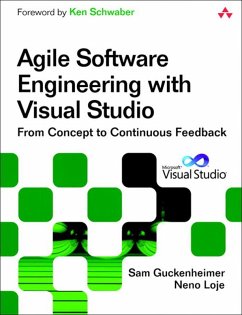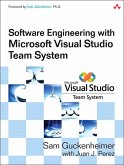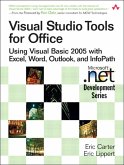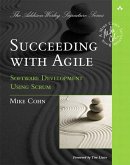Using agile methods and the tools of Visual Studio 2010, development teams can deliver higher-value software faster, systematically eliminate waste, and increase transparency throughout the entire development lifecycle. Now, Microsoft Visual Studio product owner Sam Guckenheimer and leading Visual Studio implementation consultant Neno Loje show how to make the most of Microsoft's new Visual Studio 2010 Application Lifecycle Management (ALM) tools in your environment.
This book is the definitive guide to the application of agile development with Scrum and modern software engineering practices using Visual Studio 2010. You'll learn how to use Visual Studio 2010 to empower and engage multidisciplinary, self-managing teams and provide the transparency they need to maximize productivity. Along the way, Guckenheimer and Loje help you overcome every major impediment that leads to stakeholder dissatisfaction-from mismatched schedules to poor quality, blocked builds to irreproducible bugs, and technology "silos" to geographic "silos."
Coverage includes . Accelerating the "flow of value" to customers in any software project, no matter how large or complex . Empowering high-performance software teams and removing overhead in software delivery . Automating "burndowns" and using dashboards to gain a real-time, multidimensional view of quality and progress . Using Visual Studio 2010 to reduce or eliminate "no repro" bugs . Automating deployment and virtualizing test labs to make continuous builds deployable . Using Test Impact Analysis to quickly choose the right tests based on recent code changes . Working effectively with sources, branches, and backlogs across distributed teams . Sharing code, build automation, test, project and other data across .NET and Java teams . Uncovering hidden architectural patterns in legacy software, so you can refactor changes more confidently . Scaling Scrum to large, distributed organizations
Whatever your discipline, this book will help you use Visual Studio 2010 to focus on what really matters: building software that delivers exceptional value sooner and keeps customers happy far into the future.
This book is the definitive guide to the application of agile development with Scrum and modern software engineering practices using Visual Studio 2010. You'll learn how to use Visual Studio 2010 to empower and engage multidisciplinary, self-managing teams and provide the transparency they need to maximize productivity. Along the way, Guckenheimer and Loje help you overcome every major impediment that leads to stakeholder dissatisfaction-from mismatched schedules to poor quality, blocked builds to irreproducible bugs, and technology "silos" to geographic "silos."
Coverage includes . Accelerating the "flow of value" to customers in any software project, no matter how large or complex . Empowering high-performance software teams and removing overhead in software delivery . Automating "burndowns" and using dashboards to gain a real-time, multidimensional view of quality and progress . Using Visual Studio 2010 to reduce or eliminate "no repro" bugs . Automating deployment and virtualizing test labs to make continuous builds deployable . Using Test Impact Analysis to quickly choose the right tests based on recent code changes . Working effectively with sources, branches, and backlogs across distributed teams . Sharing code, build automation, test, project and other data across .NET and Java teams . Uncovering hidden architectural patterns in legacy software, so you can refactor changes more confidently . Scaling Scrum to large, distributed organizations
Whatever your discipline, this book will help you use Visual Studio 2010 to focus on what really matters: building software that delivers exceptional value sooner and keeps customers happy far into the future.
Dieser Download kann aus rechtlichen Gründen nur mit Rechnungsadresse in A, B, BG, CY, CZ, D, DK, EW, E, FIN, F, GR, HR, H, IRL, I, LT, L, LR, M, NL, PL, P, R, S, SLO, SK ausgeliefert werden.









